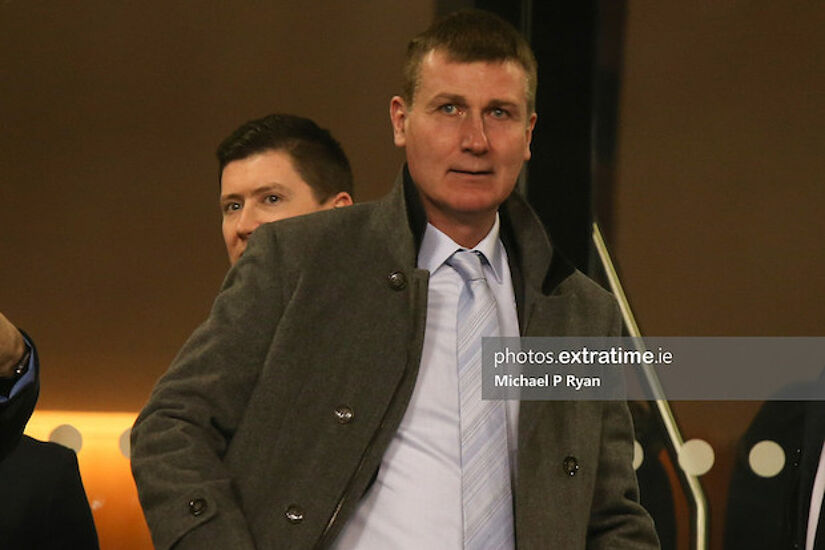Ireland's transformation under Stephen Kenny is nearly complete one year on

Stephen Kenny Credit: Michael P Ryan (ETPhotos)
After a difficult start to his tenure as Republic of Ireland manager; it looks like Stephen Kenny’s vision for a free flowing attack is finally coming into fruition.
The Dubliner took over last year after a mixed Euro 2020 qualifying campaign - which saw just three victories and four goals in six games. This followed a dismal showing in the Nations League – four games and one goal scored against five conceded.
It was a goalscoring crisis and Kenny was tasked with bringing his attacking philosophy to the national team, a vision which won four League of Ireland titles in five years with Dundalk.
His first assignment was a game against Bulgaria in the Nations League and the team were instructed to retain the ball and dominate possession. To do this, they played in a 4-3-3 formation, which allowed for greater numbers in midfield.
The Boys in Green accomplished this by attempting 581 passes and 87% of these were accurate. Ireland had 63% of possession that night but they struggled turning this into meaningful chances, as only 3 of Ireland’s 14 chances were on target.
The team switched to a 4-2-3-1 formation after a 1-0 defeat to Finland in Dublin. This systeme was then used versus Slovakia in the Euro 2020 play-off semi-final, away to England in a friendly, and against Finland and Wales in the Nations League.
Striker rotation
Kenny was clearly searching for a system that would suit his squad. He also experimented by rotating his striker.
Sean Maguire, Adam Idah, and Josh Collins all started games for Ireland up-top during this period and the Cork-man won Stephen Kenny’s vote of confidence. When Ireland returned to the 4-3-3 formation for games against Wales and Bulgaria, Idah started.
Over the winter Stephen Kenny plotted, his mind clearly preoccupied with Ireland’s issues up-front. The autumn internationals had seen the country’s longest ever goal-drought. The Dubliner decided to shake things up with a 3-5-2 formation for a World Cup qualifier against Serbia.
The formation has benefits both offensively as the full-backs join the attack creating an overlap and it has benefits defensively as the midfield shields the back three.
This tactical shift nearly paid off as Alan Browne and Josh Collins scored before Aaron Connolly was denied a stonewall penalty. Ireland ended up losing 3-2 that night, but they left the Serbian capital clearly inspired by their performance.
Three-Five-Two
Ireland played a more attacking 3-5-2 in Dublin for their next qualifier and they dominated the game. Stephen Kenny’s side had 63% possession and they played 559 passes, but they only managed three shots on target. The frustration was made worse when Luxembourg broke and scored the only goal of the game.
Stephen Kenny’s team were clearly onto something. For the Portugal clash, Ireland stuck to the 3-5-2 which was set up defensively. The back three was designated to cover the penalty box, with Matt Doherty and Seamus Coleman positioned as wing-backs. Josh Cullen and Jeff
Hendrick shielded the back three, which congested the centre and pushed Portugal’s attack wide.
The narrow defence was complimented by a pass and move counter. Ireland had a 71% pass accuracy from 28% possession that evening and this lead to six shots, two of which were on target. This was an incredibly effective use of the ball and it showed a team effectively using Kenny’s system against quality opposition.
Attacking system
While Ireland lost to an injury time goal, the team were applauded. One month later the system was tinkered for a qualifier against Azerbaijan, with the 3-5-2 becoming a more attacking 3-4-2-1. Ireland played Callum Robinson alongside Daryl Horgan behind Adam Idah and the three-pronged attack proved too much for Azerbaijan.
Callum Robinson was often left unmarked as the Azerbaijani defence scrambled to cover. He ran riot in the space created, scoring twice in the first half. Chiedozie Ogbene made it 3-0 in injury time with a header from a corner. The result was Stephen Kenny’s first competitive victory since taking over, and it was done off 36% possession and 319 passes.
Stephen Kenny reverted to 3-5-2 for Portugal’s visit to Dublin in November. They repeated September’s ambush by packing the centre forcing Portugal wide. Every attack came from passing the ball out before releasing Ogbene or Robinson. Ireland attempted 489 passes as they built from the back and completed 399 of them.
Ireland finished the game with an xG of 0.62, compared to Portugal’s 0.52.
The last game of the year is Sunday against Luxembourg. Qualification to next winter’s World Cup is mathematically impossible, but fans and stakeholders do not seem to mind. As the banner said against Serbia at home: In Kenny We Trust.
After waiting patiently for a year, Irish football fans are finally seeing Kenny’s vision come to life.
Stephen Kenny: 'I think we're improving as a team overall; we still need to improve again.' https://t.co/MpKJ6dKATOpic.twitter.com/zxT3OmbyLF
— Extratime.com (@ExtratimeNews) November 14, 2021

